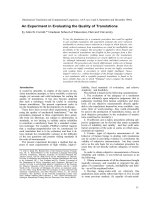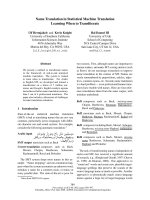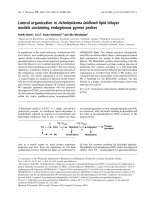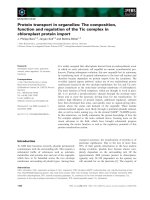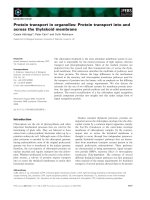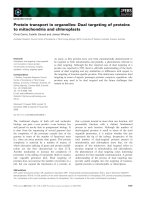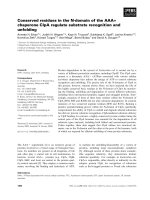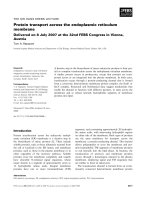Báo cáo khoa học: Protein transport in organelles: Dual targeting of proteins to mitochondria and chloroplasts ppt
Bạn đang xem bản rút gọn của tài liệu. Xem và tải ngay bản đầy đủ của tài liệu tại đây (393.01 KB, 9 trang )
MINIREVIEW
Protein transport in organelles: Dual targeting of proteins
to mitochondria and chloroplasts
Chris Carrie, Estelle Giraud and James Whelan
Australian Research Council Centre of Excellence in Plant Energy Biology, M316, University of Western Australia, Crawley, Australia
The traditional dogma of both cell and molecular
biology, one gene fi one protein fi one location, has
well passed its use-by date in postgenomic biology. It
is clear from the sequencing of several genomes that
the complexity of the proteome exceeds that of the
genome in terms of the number of functional units
(i.e. there are more proteins than genes). This protein
complexity is achieved by a number of means, of
which alternative splicing of genes and protein modifi-
cation are the best characterized to date [1–3].
Another mechanism to increase the complexity of
proteomes is the editing of transcripts (both in nuclear
and organelle genomes) [4,5]. Dual targeting of
proteins does not increase the number of proteins in a
cell, but can expand the function(s) of a protein, in
that a protein located in more than one location, will
presumably function with a distinct biochemical
process in each location. Although the number of
dual-targeted proteins is small in terms of the total
organelle proteomes, it is unclear whether this just
represents the tip of the iceberg. Irrespective of the
total number of dual-targeted proteins present in
mitochondria and chloroplasts (note that, for the
purpose of this minireview, dual targeted refers to
proteins targeted to mitochondria and chloroplasts),
the phenomenon of dual targeting raises interesting
questions for inter-organelle communication. A greater
understanding of the process of dual targeting may
provide useful insights into the targeting of location-
specific proteins to mitochondria or chloroplasts.
Keywords
chloroplast; dual targeting; inter-organelle
communication; mature protein;
mitochondria; processing; receptor;
regulation; sorting; targeting signal
Correspondence
J. Whelan, Australian Research Council
Centre of Excellence in Plant Energy
Biology, University of Western Australia, 35
Stirling Highway, Crawley 6009, Australia
Fax: +61 8 6488 4401
Tel: +61 8 6488 1749
E-mail:
Website: .
edu.au
(Received 13 August 2008, revised 19
November 2008, accepted 27 November
2008)
doi:10.1111/j.1742-4658.2009.06876.x
As many as fifty proteins have now been experimentally demonstrated to
be targeted to both mitochondria and plastids, a phenomenon referred to
as dual targeting. Although the first reported case of dual targeting of a
protein was reported in 1995, there is still little understanding of the mech-
anism of dual targeting and any similarities or differences with respect to
the targeting of location-specific proteins. This minireview summarizes dual
targeting in terms of signals, passenger proteins, receptors, regulation, why
proteins may need to be dual targeted and the future challenges that
remain in this area.
Abbreviations
GFP, green fluorescent protein; GR, glutathione reductase; MPP, mitochondrial processing peptidase; NDC1, type II alternative NAD(P)H
dehydrogenase; RPS16, 16 kDa proteins of the small ribosomal subunit of mitochondria or chloroplasts; SPP, stromal processing peptidase;
Toc, translocase at the outer envelope membrane of chloroplasts; Tom, translocase at the outer mitochondrial membrane.
FEBS Journal 276 (2009) 1187–1195 ª 2009 The Authors Journal compilation ª 2009 FEBS 1187
Dual targeting was first reported for Pisum sativum
(pea) glutathione reductase (GR) in 1995 [6], and, to
date, as many as 47 different proteins have been
reported to be dual-targeted from seven different plant
species (see Table S1). It is notable that there are also
reports of dual-targeted proteins to chloroplasts and
the nucleus [7], to chloroplasts and the peroxisome
[8,9], and, in Chlamydomonas reinhardtii, to chloro-
plasts and the endoplasmic reticulum [10]. However,
by far the greatest number of dual-targeted proteins
known are targeted to chloroplasts and mitochondria.
With the advent of complete genome sequence infor-
mation and the combined information emerging from
organelle proteome studies [11], green fluorescent pro-
tein (GFP) tagging studies [12], and bioinformatic pre-
diction of subcellular localization [13], the number of
dual-targeted proteins has increased in the last 5 years
such that they can be no longer be treated as an exce-
ption compared to location-specific proteins. Dual
targeting can be achieved via two basic mechanisms
[14,15]: alternative transcription initiation or splicing
and ambiguous targeting signals (Fig. 1). Alternative
transcriptional initiation or splicing represents tran-
scriptional or post-transcriptional events that produce
location-specific targeted proteins [16]. This mechanism
of dual targeting will not be discussed further here
[17,18]. Instead, we provide an overview the signals,
proteins, receptors, sorting of dual-targeted proteins
and why dual targeting may occur. Finally, an outline
of the future challenges in this field is provided, and
the insights that may be gained from a greater under-
standing of the mechanism of dual targeting for the
targeting of location-specific proteins is discussed.
Targeting signals and mature proteins
Targeting signals
Analysis of dual targeting signals indicates that they
are rather similar to plastidic and mitochondrial tar-
geting signals, in that they are enriched in positively
charged residues, and significantly deficient in acidic
residues and glycine [19]. However, there are no fea-
tures detectable to date that could distinguish them as
a group from location-specific targeted proteins. They
appear to fall between mitochondrial and chloroplastic
targeting signals in terms of arginine and serine con-
tent (i.e. not as high as in mitochondrial targeting
signals) and may be slightly enriched in hydrophobic
residues. In yeast, proteins targeted to mitochondria
Fig. 1. Overview of dual targeting of proteins to mitochondria and chloroplasts in plant cells. A gene encoding a dual-targeted protein may:
(1) produce two different mRNA molecules via alternative start site for transcription initiation or alternative splicing (blue arrows), where the
two mRNA molecules encode location-specific proteins [16], or (2) produce a single mRNA molecule that gives rise to a protein that is dual
targeted via an ambiguous targeting signal (black arrows).
Dual targeting of proteins C. Carrie et al.
1188 FEBS Journal 276 (2009) 1187–1195 ª 2009 The Authors Journal compilation ª 2009 FEBS
and one other location have been reported to have a
lower mitochondrial targeting score using mitoprot
compared to exclusive mitochondrial proteins [20].
This is not observed with proteins dual targeted to
mitochondria and plastids, where the mitoprot score
for many is quite high.
Experimental analyses of dual targeting signals have
also failed to define clear facets that define dual target-
ing ability. The best studied dual targeting signal is
from pea GR [21–23]. Deletion and site-directed muta-
genesis studies reveal that although some regions may
be more important for targeting to one organelle, the
dual targeting signal is overlapping. This is consistent
with studies that have used tandem arrangements of
mitochondrial and chloroplastidic targeting signals and
shown that the passenger protein was targeted to the
location defined by the most N-terminal sequence [24].
In the case of GR, it was concluded that positive resi-
dues throughout the signal and hydrophobic residues
at the N-terminus were important for mitochondrial
import, whereas hydrophobic residues alone had the
greatest affect on chloroplast import [21]. The role of
arginine residues playing a more important role for
mitochondrial import was also observed for three
aminoacyl-tRNA synthetases [19].
It has been reported that Arabidopsis thaliana DNA
polymerase c2 is dual targeted via the use of a non-
AUG start codon (a CUG codon) in translation,
resulting in an additional seven amino acids at the
N-terminus of the protein [25]. Thus, translation from
the standard AUG produces a protein that is targeted
to chloroplasts alone but, by alternative translation site
initiation, the addition of seven amino acids to the
N-terminus results in targeting to mitochondria and
chloroplasts. This would represent an elegant mecha-
nism of dual targeting. However, experimentally, it is
difficult to demonstrate that alternative translation is
taking place in vivo. Analysis of the targeting ability of
DNA polymerase c2 in another study revealed that it
was dual targeted, but from a protein produced from
the standard AUG [26], and thus via an ambiguous
targeting signal rather than alternative translation initi-
ation site. Analysis of targeting of DNA polymerase
c2 in different tissues or cell types indicated that the
amount of GFP fluorescence from chloroplasts was
greater than GFP fluorescence from mitochondria
using the AUG start construct [26]. However, the
amount of GFP fluorescence from mitochondria using
the CUG start construct was greater in terms of it
being equal in intensity to GFP fluorescence from
plastids. Thus, the dual targeting ability of protein
starting at the standard AUG codon may be over-
looked due to differential targeting to both organelles.
In tobacco, both DNA polymerases are reported to
be dual targeted from a standard AUG codon [27], even
though they also contain the same upstream ‘inframe’
CUG. Thus, the addition of the seven amino acids may
alter partitioning to allow dual targeting to be observed.
As described below in detail, the passenger protein also
has large affect on dual targeting, and different con-
structs may favour targeting to one organelle compared
to another, especially if tested in a single tissue.
In terms of processing, pea GR is the best studied to
date [23]. Based on mobility in gels, it was concluded
that the processing site was the same in both organelles.
It has been demonstrated that purified mitochondrial
processing peptidease (MPP) and stromal processing
peptidase (SPP) are responsible for processing GR [23].
The processing requirements for MPP appear to be
more stringent in that alterations near the processing
site have a greater inhibitory affect of MPP compared to
SPP. In the case of aminoacyl tRNA synthetases, Glu
aminoacyl-tRNA synthetase was processed at the same
site in both mitochondria and chloroplasts but for Met
and Phe aminoacyl-tRNA synthetases they have differ-
ent processing sites in mitochondria and chloroplasts
[19]. However, because the latter study was carried out
with GFP as a passenger protein, and processing was
not assessed by purified peptidases, processing by chlo-
roplasts may be due to a variety of processing activities
that have been detected in chloroplasts, or due to cryptic
processing sites that can be generated when targeting
signals are fused to reporters [28,29].
Dual targeting signals do not exclusively have to
comprise cleavable N-terminal signals. A protein pro-
duced from a gene encoding the small subunit of ribo-
somes in mitochondria and plastids (RPS16) was
found to be dual targeted in Medicago truncatula and
Populus alba without a cleavable N-terminal targeting
signal [30].
Mature proteins
Analysis of the role of the mature protein in dual target-
ing in several studies reveals that it plays a crucial role
in this process, a facet that is often overlooked. Pea GR
can only support the targeting of GFP to plastids [31],
although it can support the import of phosphinothricin
acetyl transferase into both mitochondria and chloro-
plasts [6]. Assessing the targeting ability of three
sequences that have dual targeting ability revealed that,
with the pea GR targeting signal, a native mitochondrial
passenger protein was only targeted to mitochondria
and a native chloroplast passenger protein was only tar-
geted to chloroplasts [31]. By contrast, the dual target-
ing signal of Arabidopsis asparaginyl-tRNA synthetase
C. Carrie et al. Dual targeting of proteins
FEBS Journal 276 (2009) 1187–1195 ª 2009 The Authors Journal compilation ª 2009 FEBS 1189
supported targeting to both locations with the same pas-
sengers [31]. The properties of targeting of Arabidopsis
histidyl-tRNA synthetase was intermediate between
these two extremes, whereas the mitochondrial passen-
ger was only targeted to mitochondria and the chloro-
plast passenger protein was dual-targeted [31]. Further
evidence that the mature protein plays a role in dual
targeting properties is seen with an alternative
NAD(P)H dehydrogenase (NDC1). GFP is only tar-
geted to mitochondria when the targeting signal of 83
amino acids is used [32], but GFP is targeted to both
mitochondria and chloroplasts when the full protein is
fused to GFP [33]. It has also been demonstrated that,
for tRNA nucleotidyltransferase, the mature protein
plays a major role in determining partitioning between
mitochondria and chloroplasts [34]. Thus, compared to
location-specific proteins, where many studies show that
the targeting signal is sufficient to support import [35],
albeit the mature protein may affect the efficiency, the
effect of the mature protein on targeting appears to be
more pronounced in the case of dual-targeted proteins.
This likely reflects the fact that dual-targeted proteins
have evolved from proteins that were targeted to a
specific location [30]. Thus, the acquisition of the dual
targeting signal would be a constraint compared to tar-
geting of location-specific proteins to avoid loss of tar-
geting to the ‘parental’ organelle (i.e. the ambiguous
dual targeting signal is a compromise and dual targeting
ability is dependent on the passenger protein). Note
that, with dual targeting signals, different passenger
proteins affect dual targeting ability, but do not appear
to block targeting to both organelles simultaneously.
Usually, targeting to one organelle is maintained. This
is evident with GR and NDC1, when the targeting sig-
nal alone is fused to GFP, dual targeting ability is lost,
although targeting to either plastids only (GR) or mito-
chondria only (NDC1) is maintained [31,32].
Organelle receptors
Unfortunately, little is known about the organelle
receptors that recognize dual-targeted proteins. How-
ever, because the dual-targeted proteins identified to
date would be required in various types of plastids, it
suggests that they may employ different receptors com-
pared to the translocase at the outer envelope mem-
brane of chloroplasts (Toc)64 and Toc159 system used
by proteins involved in photosynthesis [36]. The
Toc159 family in Arabidopsis consists of four proteins:
Toc159, Toc132, Toc120 and Toc 90 [37]. It is possible
that one of these members is specialized in the import
of dual-targeted proteins. With references to the vari-
ous import pathways that exist for protein import into
mitochondria and plastids, no experimental studies
have been carried out to determine the import and ⁄ or
sorting pathways used by dual-targeted proteins.
In the case of mitochondrial receptors for dual-
targeted proteins, it has been shown that a double
knockout of the translocase at the outer mitochondrial
membrane (Tom), tom20,inArabidopsis, which still
contained one functional Tom20 isoform, had higher
rates of import for GR, whereas some mitochondrial
precursor proteins were decreased [38]. In the triple
tom20 knockout mutant, which has severely reduced
rates of protein import for several mitochondrial pre-
cursor proteins, the import of GR was unaffected com-
pared to the wild-type [38]. This indicates that GR can
utilize a different receptor compared to several mito-
chondrial proteins imported via the general and carrier
import pathways. The same study also assessed the
role of other outer membrane proteins on GR import.
Plant mitochondria contain an outer membrane pro-
tein of 64 kDa (OM64) that displays more than 70%
amino acid sequence identity with the chloroplast
outer envelope receptor Toc64 [23]. OM64 did not
appear to play any specific role in the import of GR
compared to mitochondrial precursor proteins. One
protein that was identified to play a role in the import
of GR into mitochondria was metaxin [38]. This mito-
chondrial outer membrane protein was first identified
in mammals, and was subsequently shown to be part
of the sorting and assembly machinery complex in
yeast (SAM), called Sam35 (also called Tom34 or
Tob35) [39]. Metaxin knockouts have severe affects on
the protein import of all proteins tested in Arabidopsis,
presumably acting indirectly because it plays a role in
import and ⁄ or assembly of b-barrel proteins into the
outer mitochondrial membrane [38,39]. However, using
an alternative method to assess a role in import, the
addition of in vitro synthesized metaxin to import reac-
tion mixtures can compete for the import of GR into
mitochondria, and some but not all other mitochon-
drial proteins tested, suggesting that it plays some role
in import of GR on the cytosolic surface of the outer
membrane. Notably, metaxin was also up-regulated in
abundance in the double and triple tom20 knockout
mutants, where import of mitochondrial precursor
proteins was affected but GR was not [38].
Sorting and regulation
There is no direct experimental evidence demonstrating
that dual-targeted proteins are actively sorted or that
sorting between organelles is regulated. However, there
are several observations that suggest sorting is not
simply a passive process. Most dual-targeted proteins
Dual targeting of proteins C. Carrie et al.
1190 FEBS Journal 276 (2009) 1187–1195 ª 2009 The Authors Journal compilation ª 2009 FEBS
contain the sequence motif for phosphorylation by a
cytosolic protein kinase that acts as a guidance com-
plex to the Toc complex of chloroplasts (see Table S1).
Any regulation of the activity of this complex could
change the partitioning of dual-targeted proteins
between mitochondria and chloroplasts [40,41]. Muta-
tion of this site in GR [21], and indeed in chloroplast-
specific targeted proteins [42], does not appear to affect
the amount or rate of import. However, in vitro import
assays often employ animal-based translation lysates,
or, even in plant-based systems, translation mixtures
are prepared in advance and frozen. In such in vitro
import systems with a single purified organelle, this
system of regulation may be by-passed or go unde-
tected. Where else does the protein have to go?
Dual targeting is most commonly detected using
GFP tagged proteins. Because the emphasis of many
studies has been to determine that the protein under
study is dual targeted, the reported data tend to show
cells with both mitochondria and chloroplasts that are
clearly visible. In a more comprehensive study, we
analysed the fluorescence intensity of several dual-tar-
geted proteins and found that it differed considerably
[26]. Thus, in Arabidopsis suspension cells, for some
dual-targeted proteins, targeting to chloroplasts was
most dominant, but the same constructs in onion epi-
dermal cells gave approximately equal GFP labelling
of both mitochondria and chloroplasts. Furthermore,
one study reported that, for the dual-targeted protein
sigma factor 2B, targeting to one organelle is only
observed in any one cell [43]. Another study reported
that the GFP fluorescence intensity differs between
experiments with dual-targeted proteins [19]. Such
reports are likely to increase in the future.
One interesting opportunity for regulation of parti-
tioning dual-targeted proteins is the possibility that
mRNA for dual-targeted proteins is targeted to the
organelle surface [23]. Regulation of targeting of
mRNA could result in changes in partitioning. As yet,
there is no evidence for mRNA targeting to mitochon-
dria or plastids, even for mRNA encoding location-
specific proteins.
Why dual target proteins?
Mitochondria and chloroplasts share many common
enzymatic steps that are catalysed by location-specific
proteins [44]. Thus, it is unclear why some and, at this
stage, a relatively small number of activities are carried
out by dual-targeted proteins. Furthermore, in many
cases where a dual-targeted protein exists, location-
specific isoforms also exist. Thus, dual targeting does
not appear to be a strategy of limiting gene number in
the nuclear genome. As outlined previously, dual tar-
geting of proteins appears to have arose before the
monocot ⁄ dicot split [30], and is present in several plant
species (see Table S1). The RPS16 protein gives an
interesting insight into the evolutionarily history of
dual targeting. In both Arabidopsis and Oryza sativa
(rice), the chloroplast genome contains a functional
gene encoding this protein; however, the nuclear
located gene that encodes the mitochondrial protein
has dual targeting ability. Thus, acquisition of dual
targeting ability may be a pre-requisite or at least facil-
itate the loss of organelle genes. Therefore, dual target-
ing of proteins may have been more widespread,
occurring early in the evolutionarily history of plants.
Characterization of organelle RNA polymerases in
Physcomitrella patens concluded that there is no dual-
targeted isoform [45], in contrast to previous studies
[46]. Thus, it is unclear how widespread and conserved
dual targeting is in plant evolution.
An examination of proteins that are dual targeted
reveals that they differ substantially in functional cate-
gorization compared to a genome wide classification
(Fig. 2; see also Table S1). Dual-targeted proteins
appear to be particularly enriched in the categories of
cell cycle and DNA synthesis, and protein synthesis
(Fig. 2; see also Table S1). This may simply be due to
the fact that a limited number of dual-targeted pro-
teins are known because dual-targeted proteins also
have significantly less proteins of uncharacterized fun-
ction compared to the whole genome (Fig. 2). Exami-
nation of the expression patterns of dual-targeted
proteins across several tissue types and developmental
stages reveals that they are relatively static, displaying
similar levels of expression across green and not green
tissues and across developmental stages ranging from
embryonic to senescence (see Fig. S1). This suggests
that they encode basic but essential functions required
in mitochondria and plastids. An examination of the
list of dual-targeted proteins also reveals that several
steps in a biochemical process may be dual targeted
(e.g. the process of organelle gene expression, proteins
involved in DNA replication, transcription and trans-
lation are dual targeted, and for the ascorbate glutathi-
one cycle, several enzymes are dual targeted) [47]. For
both these processes, location-specific isoforms also
exist for many steps.
The reason for dual targeting a protein may com-
prise a means of inter-organelle communication. Send-
ing the same proteins to both organelles at the same
time ensures that they are both at least capable of
carrying out these functions in a co-ordinated manner.
Organelle genome replication and number may
have also have roles beyond their immediate coding
C. Carrie et al. Dual targeting of proteins
FEBS Journal 276 (2009) 1187–1195 ª 2009 The Authors Journal compilation ª 2009 FEBS 1191
capacity. In human cancers, the depletion of mitochon-
drial DNA is associated with altered methylation pat-
terns in the nucleus, and restoration of mitochondrial
DNA reverses these changes [48]. Given that epigenetic
regulation can have widespread affects beyond specific
organelle functions [49], in plant cells that contain two
organelles with their own genomes, it may be necessary
at times to co-ordinate the replication and ⁄ or expres-
sion of both organelle genomes.
At the level of the individual functions encoded by
dual-targeted proteins, it is likely that the activities
encoded are required in both organelles at the same
time. Thus, dual-targeted glutamine synthetase plays a
role in assimilating ammonia that is produced in the
mitochondria during photorespiration, which com-
prises the best known biochemical process that links
mitochondrial and chloroplast function [50]. The fact
that GR and the associated enzymes in the ascorbate
glutathione cycle are dual targeted is not surprising
given that mitochondria are the site of ascorbate syn-
thesis, and that this cycle plays an important role in
both organelles in maintaining cellular redox balance
[51]. Thus, taking the current list of dual-targeted pro-
teins as a whole or at an individual level, the activities
provide a direct link between organelle functions,
which is not achieved by other communication path-
ways, such as retrograde regulation [52,53].
Future challenges
The understanding of the mechanism of dual targeting
is at a very early stage compared to that of location-
specific proteins. Defining the plastidic and mitochon-
drial receptor(s) for dual-targeted proteins would
represent a major landmark, in that a comparison with
the binding of location-specific proteins to their
Fig. 2. Functional categorization of proteins dual targeted to mitochondria and chloroplasts in Arabidopsis. The number of proteins in each
classification is expressed as a percentage of the total number of proteins in each set and compared to the functional classification of all pro-
teins in Arabidopsis. An asterisk (*) indicates a significant difference at a 99% confidence interval compared to the whole genome using a
chi-squared test.
Dual targeting of proteins C. Carrie et al.
1192 FEBS Journal 276 (2009) 1187–1195 ª 2009 The Authors Journal compilation ª 2009 FEBS
cognate receptors may reveal what is required for dual
targeting, and also what is required to avoid mis-sort-
ing of proteins between mitochondria and chloroplasts.
The structures of binding of targeting peptides to
mammalian and plant Tom20s not only revealed the
molecular details of binding [54,55], but also prompted
the hypothesis of an elegant example of convergent
evolution [54,56] because plant and mammalian
Tom20s are not orthologous. One of the most compel-
ling questions concerning dual targeting is how the
proteins are partitioned between both organelles?
Thus, a better understanding of the role of any cyto-
solic factors involved, and whether they play any regu-
latory role, would explain how each organelle obtains
the appropriate amount of protein. An understanding
of why dual targeting occurs will require the evolution-
arily history of dual targeting to be determined in
more detail in terms of when it arose and whether it is
conserved. A complete understanding of dual targeting
also requires an understanding of why it occurs. This
is probably best achieved by converting dual-targeted
proteins to location-specific isoforms and assessing
organelle function. For dual-targeted proteins that
have location-specific isoforms, it is not clear whether
the dual-targeted isoform has taken on new functions
(neofunctionalization) or whether expression is special-
ized (subfunctionalization). Promoter swapping studies
between dual and location-specific isoforms may also
be informative for assessing the function of dual-
targeted proteins.
Acknowledgement
Work on dual targeting by J.W. is supported by an
Australian Research Council grant DP0664692.
References
1 Kazan K (2003) Alternative splicing and proteome
diversity in plants: the tip of the iceberg has just
emerged. Trends Plant Sci 8, 468–471.
2 Siuti N & Kelleher NL (2007) Decoding protein modifi-
cations using top-down mass spectrometry. Nat Meth-
ods 4, 817–821.
3 Witze ES, Old WM, Resing KA & Ahn NG (2007)
Mapping protein post-translational modifications with
mass spectrometry. Nat Methods 4, 798–806.
4 Nishikura K (2006) Editor meets silencer: crosstalk
between RNA editing and RNA interference. Nat Rev
Mol Cell Biol 7, 919–931.
5 Takenaka M, Verbitskiy D, van der Merwe JA, Zehr-
mann A & Brennicke A (2008) The process of RNA
editing in plant mitochondria. Mitochondrion 8, 35–46.
6 Creissen G, Reynolds H, Xue Y & Mullineaux P (1995)
Simultaneous targeting of pea glutathione reductase and
of a bacterial fusion protein to chloroplasts and mito-
chondria in transgenic tobacco. Plant J 8, 167–175.
7 Schwacke R, Fischer K, Ketelsen B, Krupinska K &
Krause K (2007) Comparative survey of plastid and
mitochondrial targeting properties of transcription fac-
tors in Arabidopsis and rice. Mol Genet Genomics 277,
631–646.
8 Sapir-Mir M, Mett A, Belausov E, Tal-Meshulam S,
Frydman A, Gidoni D & Eyal Y (2008) Peroxisomal
localization of Arabidopsis isopentenyl diphosphate
isomerases suggests that part of the plant isoprenoid
mevalonic acid pathway is compartmentalized to per-
oxisomes. Plant Physiol 148, 1219–1228.
9 Reumann S, Babujee L, Ma C, Wienkoop S, Siemsen
T, Antonicelli GE, Rasche N, Lu
¨
der F, Weckwerth W
& Jahn O (2007) Proteome analysis of Arabidopsis leaf
peroxisomes reveals novel targeting peptides, metabolic
pathways, and defense mechanisms. Plant Cell 19,
3170–3193.
10 Levitan A, Trebitsh T, Kiss V, Pereg Y, Dangoor I &
Danon A (2005) Dual targeting of the protein disulfide
isomerase RB60 to the chloroplast and the endoplasmic
reticulum. Proc Natl Acad Sci USA 102, 6225–6230.
11 Heazlewood JL, Verboom RE, Tonti-Filippini J, Small
I & Millar AH (2007) SUBA: the Arabidopsis subcellu-
lar database. Nucleic Acids Res 35, D213–D218.
12 Koroleva OA, Tomlinson ML, Leader D, Shaw P &
Doonan JH (2005) High-throughput protein localization
in Arabidopsis using Agrobacterium-mediated transient
expression of GFP-ORF fusions. Plant J 41, 162–174.
13 Cho SH, Chung YS, Cho SK, Rim YW & Shin JS
(1999) Particle bombardment mediated transformation
and GFP expression in the moss Physcomitrella patens.
Mol Cells 9, 14–19.
14 Karniely S & Pines O (2005) Single translation–dual
destination: mechanisms of dual protein targeting in
eukaryotes. EMBO Rep 6, 420–425.
15 Peeters N & Small I (2001) Dual targeting to mitochon-
dria and chloroplasts. Biochim Biophys Acta 1541, 54–63.
16 Dinkins RD, Majee SM, Nayak NR, Martin D, Xu Q,
Belcastro MP, Houtz RL, Beach CM & Downie AB
(2008) Changing transcriptional initiation sites and
alternative 5¢- and 3¢-splice site selection of the first
intron deploys Arabidopsis protein isoaspartyl methyl-
transferase2 variants to different subcellular compart-
ments. Plant J 55, 1–13.
17 Millar AH, Whelan J & Small I (2006) Recent surprises
in protein targeting to mitochondria and plastids. Curr
Opin Plant Biol 9, 610–615.
18 Silva-Filho MC (2003) One ticket for multiple destina-
tions: dual targeting of proteins to distinct subcellular
locations. Curr Opin Plant Biol 6, 589–595.
C. Carrie et al. Dual targeting of proteins
FEBS Journal 276 (2009) 1187–1195 ª 2009 The Authors Journal compilation ª 2009 FEBS 1193
19 Pujol C, Marechal-Drouard L & Duchene AM (2007)
How can organellar protein N-terminal sequences be
dual targeting signals? In silico analysis and mutagenesis
approach. J Mol Biol 369, 356–367.
20 Dinur-Mills M, Tal M & Pines O (2008) Dual targeted
mitochondrial proteins are characterized by lower
MTS parameters and total net charge. PLoS ONE 3,
e2161.
21 Chew O, Rudhe C, Glaser E & Whelan J (2003) Char-
acterization of the targeting signal of dual-targeted pea
glutathione reductase. Plant Mol Biol 53, 341–356.
22 Rudhe C, Chew O, Whelan J & Glaser E (2002) A
novel in vitro system for simultaneous import of pre-
cursor proteins into mitochondria and chloroplasts.
Plant J 30, 213–220.
23 Rudhe C, Clifton R, Chew O, Zemam K, Richter S,
Lamppa G, Whelan J & Glaser E (2004) Processing of
the dual targeted precursor protein of glutathione
reductase in mitochondria and chloroplasts. J Mol Biol
343, 639–647.
24 de Castro Silva Filho M, Chaumont F, Leterme S &
Boutry M (1996) Mitochondrial and chloroplast target-
ing sequences in tandem modify protein import specific-
ity in plant organelles. Plant Mol Biol 30, 769–780.
25 Christensen AC, Lyznik A, Mohammed S, Elowsky
CG, Elo A, Yule R & Mackenzie SA (2005) Dual-
domain, dual-targeting organellar protein presequences
in Arabidopsis can use non-AUG start codons. Plant
Cell 17, 2805–2816.
26 Carrie C, Kuhn K, Murch M, Duncan O, Small I,
O’Toole N & Whelan J (2008) Approaches to defining
dual targeted protein in Arabidopsis. Plant J, doi:
10.1111/j.1365-313X.2008.03745.x.
27 Ono Y, Sakai A, Takechi K, Takio S, Takusagawa M
& Takano H (2007) NtPolI-like1 and NtPolI-like2, bac-
terial DNA polymerase I homologs isolated from BY-2
cultured tobacco cells, encode DNA polymerases
engaged in DNA replication in both plastids and mito-
chondria. Plant Cell Physiol 48, 1679–1692.
28 Duby G, Oufattole M & Boutry M (2001) Hydrophobic
residues within the predicted N-terminal amphiphilic
alpha-helix of a plant mitochondrial targeting prese-
quence play a major role in in vivo import. Plant J 27,
539–549.
29 Musgrove BT & Malden NJ (1989) Mediastinitis and
pericarditis caused by dental infection. Br J Oral Max-
illofac Surg 27, 423–428.
30 Ueda M, Nishikawa T, Fujimoto M, Takanashi H,
Arimura SI, Tsutsumi N & Kadowaki KI (2008)
Substitution of the gene for chloroplast RPS16 was
assisted by generation of a dual targeting signal.
Mol Biol Evol 25, 1566–1575.
31 Chew O & Whelan J (2003) Dual targeting ability of
targeting signals is dependent on the nature of the
mature protein. Funct Plant Biol 30, 805–812.
32 Michalecka AM, Svensson AS, Johansson FI, Agius
SC, Johanson U, Brennicke A, Binder S & Rasmusson
AG (2003) Arabidopsis genes encoding mitochondrial
type II NAD(P)H dehydrogenases have different evolu-
tionary origin and show distinct responses to light.
Plant Physiol 133, 642–652.
33 Carrie C, Murcha MW, Kuehn K, Duncan O, Barthet
M, Smith PM, Eubel H, Meyer E, Day DA, Millar AH
et al. (2008) Type II NAD(P)H dehydrogenases are
targeted to mitochondria and chloroplasts or
peroxisomes in Arabidopsis thaliana. FEBS Lett 582,
3073–3079.
34 von Braun SS, Sabetti A, Hanic-Joyce PJ, Gu J, Schleiff
E & Joyce PB (2007) Dual targeting of the tRNA
nucleotidyltransferase in plants: not just the signal.
J Exp Bot 58, 4083–4093.
35 Glaser E, Sjoling S, Tanudji M & Whelan J (1998)
Mitochondrial protein import in plants. Signals, sorting,
targeting, processing and regulation. Plant Mol Biol 38,
311–338.
36 Soll J & Schleiff E (2004) Protein import into chlorop-
lasts. Nat Rev Mol Cell Biol 5, 198–208.
37 Jarvis P (2008) Targeting of nucleus-encoded proteins
to chloroplasts in plants. New Phytol 179, 257–285.
38 Lister R, Carrie C, Duncan O, Ho LH, Howell KA,
Murcha MW & Whelan J (2007) Functional definition
of outer membrane proteins involved in preprotein
import into mitochondria. Plant Cell 19, 3739–3759.
39 Neupert W & Herrmann JM (2007) Translocation of
proteins into mitochondria. Annu Rev Biochem 76,
723–749.
40 Martin T, Sharma R, Sippel C, Waegemann K, Soll J
& Vothknecht UC (2006) A protein kinase family in
Arabidopsis phosphorylates chloroplast precursor
proteins. J Biol Chem 281, 40216–40223.
41 Waegemann K & Soll J (1996) Phosphorylation of the
transit sequence of chloroplast precursor proteins.
J Biol Chem 271, 6545–6554.
42 Nakrieko KA, Mould RM & Smith AG (2004) Fidelity
of targeting to chloroplasts is not affected by removal
of the phosphorylation site from the transit peptide.
Eur J Biochem 271, 509–516.
43 Beardslee TA, Roy-Chowdhury S, Jaiswal P, Buhot L,
Lerbs-Mache S, Stern DB & Allison LA (2002) A
nucleus-encoded maize protein with sigma factor activ-
ity accumulates in mitochondria and chloroplasts. Plant
J 31, 199–209.
44 Buchanan B, Gruissem W & Jones RL (2002) Biochem-
istry and Molecular Biology of Plants. American Society
of Plant Physiologists, Rockville, MD.
45 Kabeya Y & Sato N (2005) Unique translation initia-
tion at the second AUG codon determines mitochon-
drial localization of the phage-type RNA polymerases
in the moss Physcomitrella patens. Plant Physiol 138,
369–382.
Dual targeting of proteins C. Carrie et al.
1194 FEBS Journal 276 (2009) 1187–1195 ª 2009 The Authors Journal compilation ª 2009 FEBS
46 Richter U, Kiessling J, Hedtke B, Decker E, Reski R,
Borner T & Weihe A (2002) Two RpoT genes of
Physcomitrella patens encode phage-type RNA polyme-
rases with dual targeting to mitochondria and plastids.
Gene 290, 95–105.
47 Chew O, Whelan J & Millar AH (2003) Molecular defi-
nition of the ascorbate-glutathione cycle in Arabidopsis
mitochondria reveals dual targeting of antioxidant
defenses in plants. J Biol Chem 278, 46869–46877.
48 Smiraglia DJ, Kulawiec M, Bistulfi GL, Ghoshal S &
Singh KK (2008) A novel role for mitochondria in regu-
lating epigenetic modification in the nucleus. Cancer
Biol Ther 7, 1182–1190.
49 Lister R, O’Malley RC, Tonti-Filippini J, Gregory BD,
Berry CC, Millar AH & Ecker JR (2008) Highly inte-
grated single-base resolution maps of the epigenome in
Arabidopsis. Cell 133, 523–536.
50 Linka M & Weber AP (2005) Shuffling ammonia
between mitochondria and plastids during photorespira-
tion. Trends Plant Sci 10, 461–465.
51 Noctor G, De Paepe R & Foyer CH (2007) Mitochon-
drial redox biology and homeostasis in plants. Trends
Plant Sci 12, 125–134.
52 Rhoads DM & Subbaiah CC (2007) Mitochondrial ret-
rograde regulation in plants. Mitochondrion 7, 177–194.
53 Woodson JD & Chory J (2008) Coordination of gene
expression between organellar and nuclear genomes.
Nat Rev Genet 9, 383–395.
54 Perry AJ, Hulett JM, Likic VA, Lithgow T & Gooley
PR (2006) Convergent evolution of receptors for protein
import into mitochondria. Curr Biol 16, 221–229.
55 Saitoh T, Igura M, Obita T, Ose T, Kojima R, Mae-
naka K, Endo T & Kohda D (2007) Tom20 recognizes
mitochondrial presequences through dynamic equilib-
rium among multiple bound states. EMBO J 26, 4777–
4787.
56 Lister R & Whelan J (2006) Mitochondrial protein
import: convergent solutions for receptor structure.
Curr Biol 16, R197–R199.
Supporting information
The following supplementary material is available:
Fig. S1. Relative transcript abundance of genes encod-
ing proteins dual targeted to mitochondria and plastids
in Arabidopsis.
Table S1. Overview of proteins dual targeted to mito-
chondria and plastids in plants.
This supplementary material can be found in the
online version of this article.
Please note: Wiley-Blackwell is not responsible for
the content or functionality of any supplementary
materials supplied by the authors. Any queries (other
than missing material) should be directed to the corre-
sponding author for the article.
C. Carrie et al. Dual targeting of proteins
FEBS Journal 276 (2009) 1187–1195 ª 2009 The Authors Journal compilation ª 2009 FEBS 1195

